一,基本操作
1.响应请求的方式
不响应 | void+@ResponseBody注解 |
ModelAndView | 通过setViewName方法 | 直接指定响应页面 | 返回值为String类型,返回结果指定跳转地址 |
重定向 | 跳转地址前加redirect:前缀即可 |
HttpServletRequest和HttpServletResponse | 形参中声明这两个变量。然后通过相关api跳转|
上一篇看过ModelAndView的响应方式这里就从void开始
1.返回void
返回值为void时,方法中可以不用做任何返回,在浏览器中,springmvc会默认去查找和方法同名的页面作为方法的视图返回。 如果确实不需要该方法返回页面,可以使用@ResponseBody注解,表示一个请求到此为止。
@RequestMapping("/test1")
@ResponseBody
public void test1() {
System.out.println("test1");
}
下面讲述各种请求的方式与实现代码,结果就不一一演示了
配置web.xml文件
<?xml version="1.0" encoding="UTF-8"?>
<web-app xmlns:xsi="http://www.w3.org/2001/XMLSchema-instance" xmlns="http://xmlns.jcp.org/xml/ns/javaee" xsi:schemaLocation="http://xmlns.jcp.org/xml/ns/javaee http://xmlns.jcp.org/xml/ns/javaee/web-app_3_1.xsd" id="WebApp_ID" version="3.1">
<display-name>SpringMVC-01-hello</display-name>
<welcome-file-list>
<welcome-file>index.html</welcome-file>
<welcome-file>index.htm</welcome-file>
<welcome-file>index.jsp</welcome-file>
<welcome-file>default.html</welcome-file>
<welcome-file>default.htm</welcome-file>
<welcome-file>default.jsp</welcome-file>
</welcome-file-list>
<servlet>
<servlet-name>springmvc</servlet-name>
<servlet-class>org.springframework.web.servlet.DispatcherServlet</servlet-class>
<init-param>
<param-name>contextConfigLocation</param-name>
<param-value>classpath:Spring-MVC.xml</param-value>
</init-param>
<load-on-startup>1</load-on-startup>
</servlet>
<!-- Map all requests to the DispatcherServlet for handling -->
<servlet-mapping>
<servlet-name>springmvc</servlet-name>
<url-pattern>/</url-pattern>
</servlet-mapping>
</web-app>
配置spring-mvc的配置文件
<?xml version="1.0" encoding="UTF-8"?>
<beans xmlns="http://www.springframework.org/schema/beans"
xmlns:xsi="http://www.w3.org/2001/XMLSchema-instance"
xmlns:context="http://www.springframework.org/schema/context"
xmlns:mvc="http://www.springframework.org/schema/mvc"
xsi:schemaLocation="http://www.springframework.org/schema/mvc http://www.springframework.org/schema/mvc/spring-mvc-4.3.xsd
http://www.springframework.org/schema/beans http://www.springframework.org/schema/beans/spring-beans.xsd
http://www.springframework.org/schema/context http://www.springframework.org/schema/context/spring-context-4.3.xsd">
<!-- 开启扫描 -->
<context:component-scan base-package="com.sxt"/>
<!-- 开启SpringMVC注解的方式 -->
<mvc:annotation-driven></mvc:annotation-driven>
<!-- 配置视图解析器 和Controller的一个方法一起使用后面有标记-->
<!-- <bean class="org.springframework.web.servlet.view.InternalResourceViewResolver">
<property name="prefix" value="/"/>
<property name="suffix" value=".jsp"/>
</bean> -->
</beans>
自定义的Controller,index的jsp页面内容自定义
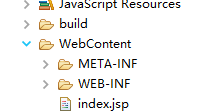
package com.sxt;
import java.io.IOException;
import javax.servlet.ServletException;
import javax.servlet.http.HttpServletRequest;
import javax.servlet.http.HttpServletResponse;
import org.springframework.stereotype.Controller;
import org.springframework.web.bind.annotation.RequestMapping;
import org.springframework.web.bind.annotation.ResponseBody;
import org.springframework.web.servlet.ModelAndView;
@Controller
@RequestMapping("/hello")
public class HelloController {
//ModelAndView,响应方式
@RequestMapping("/hello1")
public ModelAndView hello1(){
System.out.println("-----hello1---");
ModelAndView m = new ModelAndView();
m.setViewName("/index.jsp");
return m;
}
//返回一个字符串
@RequestMapping("/hello2")
@ResponseBody//该注解表示一个请求到此结束
public void hello2(){
System.out.println("aaaa");
}
/*
* 此方法需要在spring-mvc的配置文件配置视图解析器,自动添加index的前缀后缀,开启后可用这个方法
@RequestMapping("/h1")
public String hello3(){
System.out.println("111");
return "index";
}*/
//重定向跳转 :返回路径注意: 返回的字符带"/“表示从根目录下开始找,不带”/"从当前目录下查找
@RequestMapping("/h2")
public String hello4(){
System.out.println("111");
return "redirect:/index.jsp";
}
//通过request和response
@RequestMapping("/h5")
public void hello5(HttpServletRequest request,HttpServletResponse response) throws IOException, Exception{
System.out.println("333");
request.getRequestDispatcher("/index.jsp").forward(request, response);
}
}
上面方法除了视图解析器需要在配置文件配置,其余的都一样
@RequertMapping的说明
1.映射路径 @RequestMapping最基本的功能,用法:
@RequestMapping("/delete")
public String delete(){
System.out.println("波波烤鸭:删除数据操作....");
return "/hello";
}
窄化请求 窄化请求用来限定请求路径,即将@RequestMapping放在类上,这样,方法的请求路径是类上的@ReqmestMapping+方法上的@RequestMapping 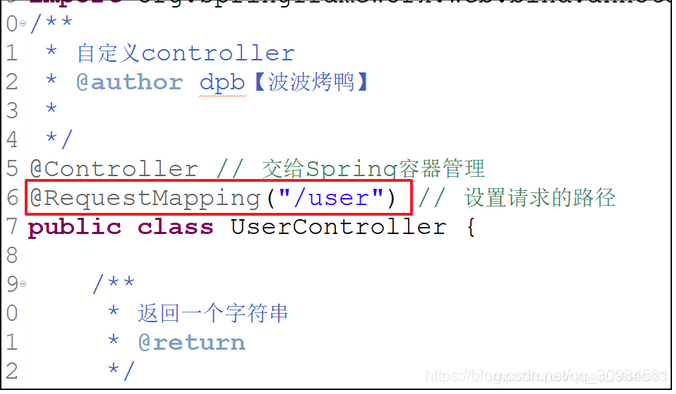 请求方法限定
请求方法限定 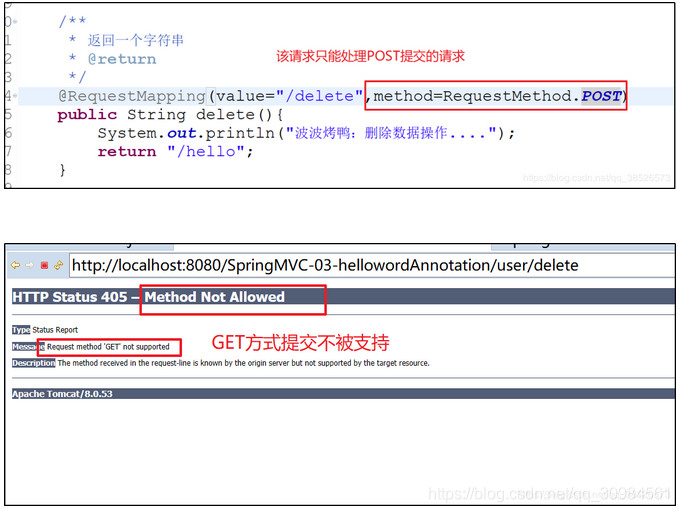
基本数据类型
java基本数据类型+string 使用基本数据类型时,参数名称和浏览器传来的参数的key一致,这样才能实现自动映射
/**
* 接收参数
* 基本数据类型
* @param id
* @param name
* @return
*/ @RequestMapping("add") public String add(int id,String name){ System.out.println(id+"---"+name); return "/hello"; }
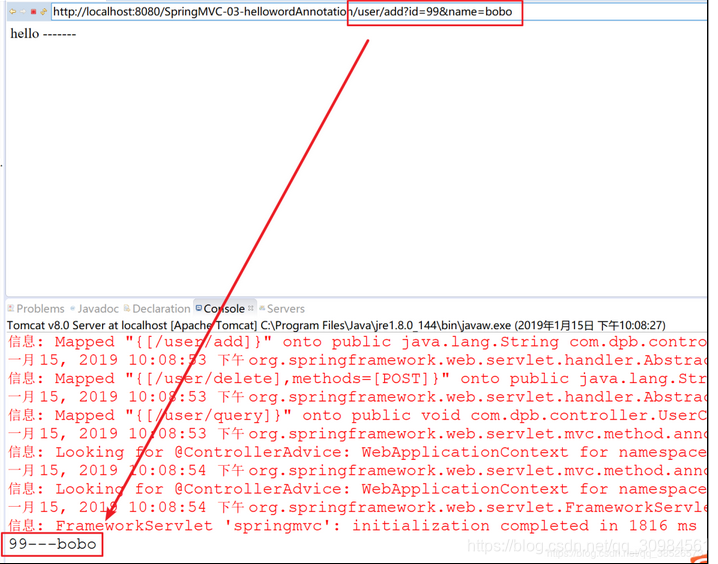
如果参数名和浏览器传来的key不一致,可以通过@RequestParam来解决。如下
/**
* 接收参数
* 基本数据类型
* 请求参数如果和形参名称不一致可以通过@RequestParam类指定
* @param id
* @param name
* @return
*/ @RequestMapping("add")
public String add(int id,@RequestParam("username")String name){
System.out.println(id+"---"+name);
return "/hello";
}
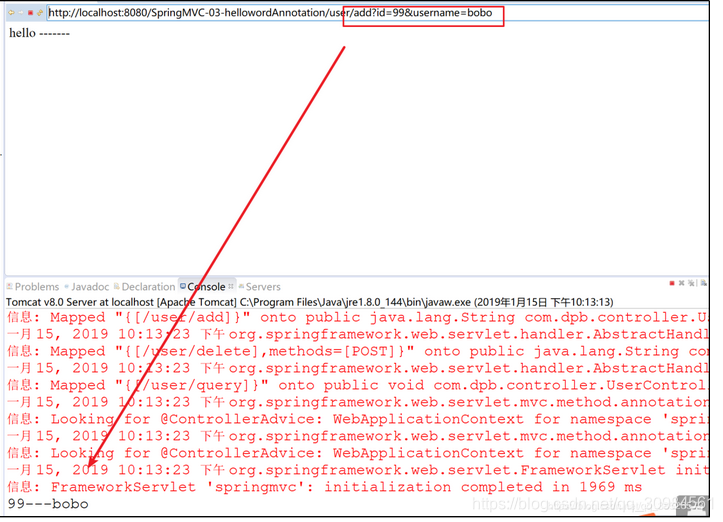
加@ReuestParam,如果为重新指定参数名,则默认的参数名依然是原本的参数名,同时也要注意,添加了这个注解后,对应的参数将成为必填参数.如果没有传递相关的参数,则会抛异常 但如果不想传参数,也有两种方式解决
1.通过required属性指定该参数不是必填的
/**
* 接收参数
* 基本数据类型
* 请求参数如果和形参名称不一致可以通过@RequestParam类指定
* @param id
* @param name
* @return
*/ @RequestMapping("add")
public String add(int id ,@RequestParam(value="username",required=false)String name){
System.out.println(id+"---"+name);
return "/hello";
}
2.通过defaultValue属性给指定参数一个默认值
/**
* 接收参数
* 基本数据类型
* 请求参数如果和形参名称不一致可以通过@RequestParam类指定
* @param id
* @param name
* @return
*/ @RequestMapping("add")
public String add(int id ,@RequestParam(value="username",defaultValue="kaoya")String name){
System.out.println(id+"---"+name);
return "/hello";
}
对象
创建一个book对象 和user对象
package com.sxt.bean;
public class Book {
private Integer id;
private String name;
@Override
public String toString() {
return "Book [id=" + id + ", name=" + name + "]";
}
public Integer getId() {
return id;
}
public void setId(Integer id) {
this.id = id;
}
public String getName() {
return name;
}
public void setName(String name) {
this.name = name;
}
}
package com.sxt.bean;
import java.util.Arrays;
import java.util.Date;
import java.util.List;
public class User {
private Integer id;
private Integer age;
private String unama;
private String[] favorites;
private List<String> list;
private Date birth;
private Book book;
@Override
public String toString() {
return "User [id=" + id + ", age=" + age + ", unama=" + unama + ", favorites=" + Arrays.toString(favorites)
+ ", list=" + list + ", birth=" + birth + ", book=" + book + "]";
}
public Integer getId() {
return id;
}
public void setId(Integer id) {
this.id = id;
}
public Integer getAge() {
return age;
}
public void setAge(Integer age) {
this.age = age;
}
public String getUnama() {
return unama;
}
public void setUnama(String unama) {
this.unama = unama;
}
public String[] getFavorites() {
return favorites;
}
public void setFavorites(String[] favorites) {
this.favorites = favorites;
}
public List<String> getList() {
return list;
}
public void setList(List<String> list) {
this.list = list;
}
public Date getBirth() {
return birth;
}
public void setBirth(Date birth) {
this.birth = birth;
}
public Book getBook() {
return book;
}
public void setBook(Book book) {
this.book = book;
}
}
创建配置文件
<?xml version="1.0" encoding="UTF-8"?>
<beans xmlns="http://www.springframework.org/schema/beans"
xmlns:xsi="http://www.w3.org/2001/XMLSchema-instance"
xmlns:context="http://www.springframework.org/schema/context"
xmlns:mvc="http://www.springframework.org/schema/mvc"
xsi:schemaLocation="http://www.springframework.org/schema/mvc http://www.springframework.org/schema/mvc/spring-mvc-4.3.xsd
http://www.springframework.org/schema/beans http://www.springframework.org/schema/beans/spring-beans.xsd
http://www.springframework.org/schema/context http://www.springframework.org/schema/context/spring-context-4.3.xsd">
<!-- 开启扫描 -->
<context:component-scan base-package="com.sxt"/>
<!-- 开启SpringMVC注解的方式 -->
<mvc:annotation-driven></mvc:annotation-driven>
</beans>
建立user.jsp页面
<%@ page language="java" contentType="text/html; charset=UTF-8"
pageEncoding="UTF-8"%>
<!DOCTYPE html PUBLIC "-//W3C//DTD HTML 4.01 Transitional//EN" "http://www.w3.org/TR/html4/loose.dtd">
<html>
<head>
<meta http-equiv="Content-Type" content="text/html; charset=UTF-8">
<title>Insert title here</title>
</head>
<body>
<form action="add" method="post">
<table>
<tr>
<td>编号</td>
<td><input type="text" name="id"></td>
</tr>
<tr>
<td>名字</td>
<td><input type="text" name="unama"></td>
</tr>
<tr>
<td>年龄</td>
<td><input type="text" name="age"></td>
</tr>
<tr>
<td>id</td>
<td><input type="text" name="book.id"></td>
</tr>
<tr>
<td>作者</td>
<td><input type="text" name="book.name"></td>
</tr>
<tr>
<td><input type="submit" value="添加"></td>
</tr>
</table>
</form>
</body>
</html>
创建自定义的Controller
package com.sxt;
import java.util.Date;
import org.springframework.stereotype.Controller;
import org.springframework.web.bind.annotation.RequestMapping;
import org.springframework.web.bind.annotation.ResponseBody;
import com.sxt.bean.User;
@Controller
public class UserController {
@RequestMapping("/add")//对象接受数据方法
@ResponseBody
public void add(User user) {
System.out.println(user);
}
}
测试
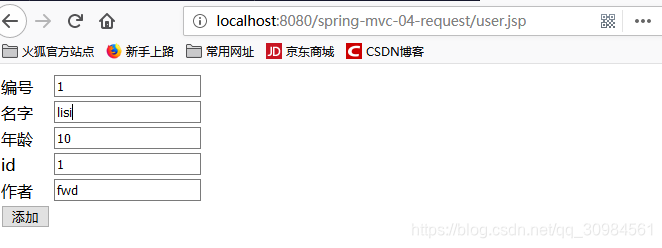

因为测试的对象所以其他都没给值
数组与集合的数据接受
bean层和配置文件,web.xml文件都一样
package com.sxt;
import java.util.Date;
import org.springframework.stereotype.Controller;
import org.springframework.web.bind.annotation.RequestMapping;
import org.springframework.web.bind.annotation.ResponseBody;
import com.sxt.bean.User;
@Controller
public class UserController {
//数组数据获取
@RequestMapping("/add2")
@ResponseBody
public void add3(User user) {
System.out.println(user);
String[] favorites = user.getFavorites();
for (String f : favorites) {
System.out.println(f);
}
}
//集合数据获取
@RequestMapping("/add3")
@ResponseBody
public void add4(User user) {
System.out.println(user);
System.out.println(user.getList());
}
}
创建对应的jsp页面
获取数组类的jsp页面 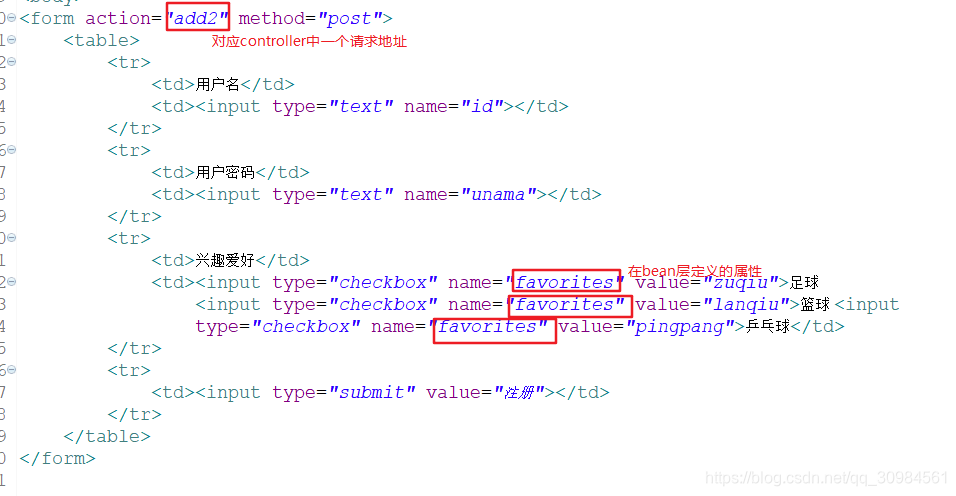 获取集合类的jsp页面
获取集合类的jsp页面 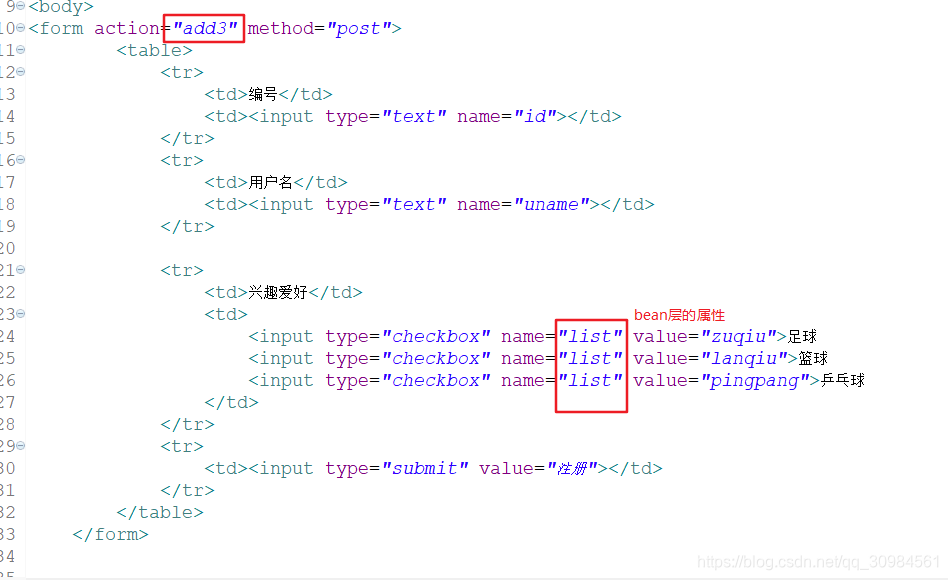
测试访问路径
数组的输出结果

集合输出结果

总结: 1.数组(无论是基本数据类型还是对象数组)都可以直接写在接口参数中。 2.集合(无论是基本数据类型还是对象)都需要一个包装类将其包装起来,不能直接写在接口参数中。 3.对于基本数据类型,数组和集合在表单中的写法是一样的 4.对于对象数据类型,数组和集合在表单中的写法是一样的
Data类型接受
接受数据类型是Data类型的需要通过转换器进行接受
自定义Controller
创建自定义的转换器
package com.sxt;
import java.util.Date;
import org.springframework.stereotype.Controller;
import org.springframework.web.bind.annotation.RequestMapping;
import org.springframework.web.bind.annotation.ResponseBody;
import com.sxt.bean.User;
@Controller
public class UserController {
@RequestMapping("/add4")
@ResponseBody
public void add4(Date d) {
System.out.println(d);
}
}
package com.sxt;
import java.text.ParseException;
import java.text.SimpleDateFormat;
import java.util.Date;
import org.springframework.core.convert.converter.Converter;
/**
* Data类型转换器
* @author Administrator
*
*/
public class Convert implements Converter<String, Date>{
@Override
public Date convert(String arg0) {
SimpleDateFormat format = new SimpleDateFormat("yyyy-MM-dd");
try {
return format.parse(arg0);
} catch (ParseException e) {
// TODO Auto-generated catch block
e.printStackTrace();
}
return null;
}
}
在spring-mvc.xml配置文件配置
<?xml version="1.0" encoding="UTF-8"?>
<beans xmlns="http://www.springframework.org/schema/beans"
xmlns:xsi="http://www.w3.org/2001/XMLSchema-instance"
xmlns:context="http://www.springframework.org/schema/context"
xmlns:mvc="http://www.springframework.org/schema/mvc"
xsi:schemaLocation="http://www.springframework.org/schema/mvc http://www.springframework.org/schema/mvc/spring-mvc-4.3.xsd
http://www.springframework.org/schema/beans http://www.springframework.org/schema/beans/spring-beans.xsd
http://www.springframework.org/schema/context http://www.springframework.org/schema/context/spring-context-4.3.xsd">
<!-- 开启扫描 -->
<context:component-scan base-package="com.sxt"/>
<!-- 开启SpringMVC注解的方式 -->
<mvc:annotation-driven conversion-service="formattingConversionServiceFactoryBean"></mvc:annotation-driven>
<bean class="org.springframework.format.support.FormattingConversionServiceFactoryBean" id="formattingConversionServiceFactoryBean">
<property name="converters">
<set>
<bean class="com.sxt.Convert"/>
</set>
</property>
</bean>
</beans>

测试


响应数据
3.1ModelAndView 3.2HttpServletRequest 3.3HttpSession 3.4Map
创建自定义controller
package com.sxt;
import java.util.Map;
import org.springframework.stereotype.Controller;
import org.springframework.ui.Model;
import org.springframework.ui.ModelMap;
import org.springframework.web.bind.annotation.RequestMapping;
import org.springframework.web.bind.annotation.SessionAttributes;
import org.springframework.web.servlet.ModelAndView;
@Controller
public class HelloController {
@RequestMapping("query1")
public String add(Map<String, Object> map){
map.put("msg", "aaaa");
return "/index.jsp";
}
@RequestMapping("query2")
public String add1(Model m){
m.addAttribute("msg", "bbb");
return "/index.jsp";
}
@RequestMapping("query3")
public String add2(ModelMap mm){
mm.addAttribute("msg", "ccc");
return "/index.jsp";
}
@RequestMapping("query4")
public ModelAndView add3(){
ModelAndView view = new ModelAndView();
view.addObject("msg", "ddd");
view.setViewName("index.jsp");
return view;
}
}
创建springmvc配置文件
<?xml version="1.0" encoding="UTF-8"?>
<beans xmlns="http://www.springframework.org/schema/beans"
xmlns:xsi="http://www.w3.org/2001/XMLSchema-instance"
xmlns:context="http://www.springframework.org/schema/context"
xmlns:mvc="http://www.springframework.org/schema/mvc"
xsi:schemaLocation="http://www.springframework.org/schema/mvc http://www.springframework.org/schema/mvc/spring-mvc-4.3.xsd
http://www.springframework.org/schema/beans http://www.springframework.org/schema/beans/spring-beans.xsd
http://www.springframework.org/schema/context http://www.springframework.org/schema/context/spring-context-4.3.xsd">
<!-- 开启扫描 -->
<context:component-scan base-package="com.sxt"/>
<!-- 开启SpringMVC注解的方式 -->
<mvc:annotation-driven ></mvc:annotation-driven>
</beans>
创建index.jsp页面
<%@ page language="java" contentType="text/html; charset=UTF-8"
pageEncoding="UTF-8"%>
<!DOCTYPE html PUBLIC "-//W3C//DTD HTML 4.01 Transitional//EN" "http://www.w3.org/TR/html4/loose.dtd">
<html>
<head>
<meta http-equiv="Content-Type" content="text/html; charset=UTF-8">
<title>Insert title here</title>
</head>
<body>
${msg}
<h3>request:${requestScope.msg }</h3>
<h3>session:${sessionScope.msg }</h3>
<h3>application:${applicationScope.msg }</h3>
</body>
</html>
request:${requestScope.msg }
session:${sessionScope.msg }
application:${applicationScope.msg }
检查msg是保存在哪一个作用域的,结果证明都是保存在request作用域的
注意:加上@SessionAttributes这个注解是将数据保存在session作用域中的.
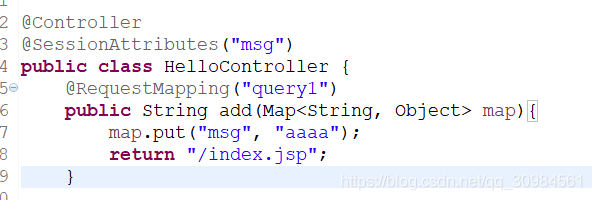
post方式提交中文乱码问题
在web.xml文件添加如下代码
<!-- spring框架提供的字符集过滤器 -->
<!-- spring Web MVC框架提供了org.springframework.web.filter.CharacterEncodingFilter用于解决POST方式造成的中文乱码问题 -->
<filter>
<filter-name>encodingFilter</filter-name>
<filter-class>org.springframework.web.filter.CharacterEncodingFilter</filter-class>
<init-param>
<param-name>encoding
</param-name>
<param-value>UTF-8</param-value>
</init-param>
</filter>
<filter-mapping >
<filter-name>encodingFilter</filter-name>
<url-pattern>/*</url-pattern>
</filter-mapping>







 本文深入探讨SpringMVC框架中不同响应方式的实现,包括void、ModelAndView、String、重定向及通过HttpServletRequest和HttpServletResponse的使用。同时,详细讲解了请求参数的接收方法,涵盖基本数据类型、对象、数组、集合以及Date类型数据的处理。
本文深入探讨SpringMVC框架中不同响应方式的实现,包括void、ModelAndView、String、重定向及通过HttpServletRequest和HttpServletResponse的使用。同时,详细讲解了请求参数的接收方法,涵盖基本数据类型、对象、数组、集合以及Date类型数据的处理。

















 1399
1399

 被折叠的 条评论
为什么被折叠?
被折叠的 条评论
为什么被折叠?








